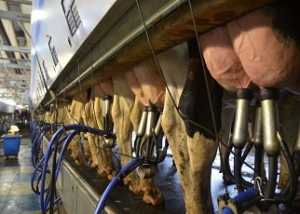Robin Schmahl with AgDairy concurs with Metzger, saying there has been a lot of adjustments being made to rations, as producers aim for least-cost rations to help manage drastically higher feed costs.
“We’re taking home higher milk prices now, but we’re seeing some changes in rations because we’ve got skyrocketing prices across the board for goods and services, and that’s probably a large reason why production per cow has been down.”
Among the top six states for milk production include:
1. California – 3.535 billion pounds, -1.9%
2. Wisconsin – 2.667 billion pounds, -0.3%
3. Texas – 1.378 billion pounds, +3.5%
4. Idaho – 1.366 billion pounds, +0.6%
5. New York – 1.378 billion pounds, -0.6%
6. Michigan – 980 million pounds, -3.5%
South Dakota Toots a Different Tune
One state worth mentioning is South Dakota, which led all states in year-over-year milk volume growth, up 18.3%. Metzger says that while South Dakota’s growth has been impressive, it still doesn’t rank in the top 15 states for total volume.
Despite not ranking in the top 15, Jason Mischel with Valley Queen Cheese Factory in Millbank, S.D., says that his state has grown 35% in milk production in the last three years and is finally getting noticed on a national stage.
Travel to Baltic, S.D. and dairy producer Lynn Boadwine remarks that the dairy growth in his state has been remarkable. Although he easily recalls the late 1990s as cow numbers were quickly dwindling. Boadwine, who milks 2,400 cows near Sioux Falls, was concerned that they were in jeopardy of losing their existing processors and would end up having nowhere to sell their milk.
“Our state stepped up and did a good job in recruiting both producers and processors,” he says. “It takes smart growth—don’t outproduce your processing capacity.”
Since then, South Dakota has worked hard to increase both cow numbers and new dairies, as well as processors. They have gained Bel Brands to Brookings and Agropur to Lake Norden, as well as seen growth in existing manufacturers, including Valley Queen.
Despite South Dakota’s growth, Metzger says that where we will produce milk in the future is pretty much where it is being produced now.
“Availability of water will become increasingly important, so will proximity to population centers if transportation becomes increasingly expensive,” he says.
While those above factors bode well for states east of the Mississippi River, also worth noting is ample processing capacity impact.
“It becomes a key factor because there’s no need to produce milk if there aren’t facilities to have it processed,” Metzger adds.
South Dakota stands firm that their state is an ideal spot for dairy and the development along the I-29 corridor illustrates that point. Boadwine says an added plus is their state’s ability to grow forages needed to feed a dairy cow—making it a very efficient place to milk cows. Although Boadwine admits while pretty much every South Dakota farmer has a combine, they don’t have to sell you corn silage.
“As important as it is to make sure you have a processor secured before producing more milk or moving into a new state, it is also advisable to secure your forage needs, too,” he notes.
Boadwine also points out that the regulations his state faces are less onerous compared to others and being less sparsely populated, South Dakota is better suited for animal agriculture.
Yes, the industry has changed at lightning speed over the last decade and while significantly more milk is being produced compared to ten years ago, the likeliness to where those cows are being milked will unlikely change moving forward. “We must grow consumption as we grow production,” Boadwine adds.























